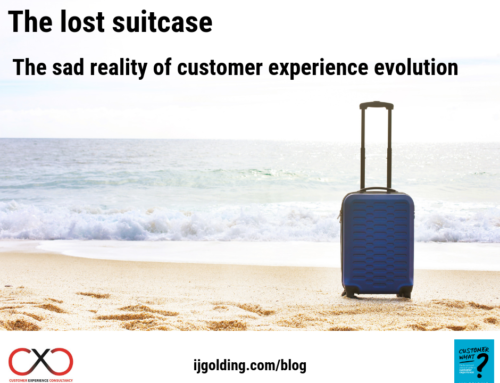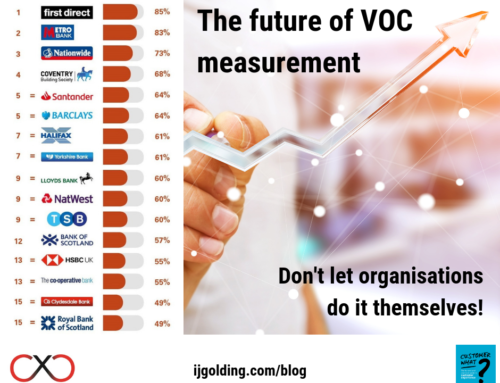
‘What does my business need to do better?’ A pretty simple question that many business owners, shareholders, boards of directors, senior managers and employees all over the world will ask, or be asked on a regular basis. Although the question is simple, the answer is often not. A number of methods, tools, techniques and strategies have, and continue to be deployed to assist in responding to the question – some have worked very successfully, some have failed dismally.
As a customer experience professional, it is always my hope that something is added to the end of the question. That something is ‘for customers’ – ‘What does my business need to do better for customers?’. This sounds pretty obvious, but in reality, what is obvious, is not always what happens. Other variants to the question include ‘What does my business need to do better to give my shareholders a better return on their investment?’; ‘What does my business need to do better to increase profits?’; What does my business need to do better to save money?’ Sadly, the variants are probably still more common than my suggestion.
Many business leaders now recognise that doing things better for customers will lead to improved top and bottom line, greater rewards for shareholders, and happier, more motivated employees. But what exactly is it that they should focus on when it comes to ‘improvement’.
Have you ever heard of the phrases ‘brilliant basics’ and ‘magic moments’? They are not new, and not phrases that I can claim as my own. However, they explain very neatly what any organisation could/should determine as their focus in attempting to meet and then exceed customer expectations or needs. How good is your business at getting the basics right – the things that your customers just expect you to do, and to do very well every time you do it. Meeting your promises; doing what you said you would do – these are the basics of your customer journey that you must and need to do brilliantly.
Understanding how ‘capable’ your customer journey is at doing what your customers ‘expect’, will allow you to understand how brilliant you are at delivering ‘the basics’, or not as the case may be. You can read about my recommended approach to measuring the customer journey in this blog post – https://ijgolding.com/2013/04/30/do-you-know-the-facts-4-steps-to-deploying-a-customer-focussed-measurement-system/.
Getting ‘the basics’ right is not as easy as it may seem. It is why methodologies such as Six Sigma came in to existence. In fact the principle of ‘continuous improvement’ centres around your ability to know how good you are at doing something today, and understanding what elements of whatever it is you do, need to be addressed to get better at doing it. Although Six Sigma is no longer the business ‘fashion statement’ it was in the 1980’s and 1990’s, it is still as valuable an approach to improving your customer journey and its enabling processes as ever.
I was inspired to write this blog post as a result of seeing an advert on TV. The advert was about an App that was launched by Barclays Bank last year. The App is called ‘Pingit’ – you can view the advert here – https://www.youtube.com/watch?v=9letFy7a0c4. I do not have a problem with the App itself – the Pingit application is a demonstration of continuous improvement in the Barclays customer journey. It has created a simple way for customers to transfer money – potentially leading to an even better solution that enables customers to pay for goods using their mobile phone. The App is a great example of a ‘Magic Moment’ – something that differentiates the Barclays Bank customer journey from other banks. It is not something that customers traditionally expect from the Barclays customer journey – it is an added bonus. Here is the Wikipedia page on the Pingit App – http://en.wikipedia.org/wiki/Barclays_Pingit.

If you watch the advert, you will notice that it makes a very big deal about the fact that you can transfer money with a photograph/image. I remember hearing about this on the radio last week. At the time, it instantly made me question why anyone would want to transfer money to someone with a photograph/image. It seems to me to be completely unnecessary, and not what I would describe as a Magic Moment. The danger of creating and designing things for customers is that you go a step too far. You end up creating something that makes your customer question why you have devoted time and money to creating something that is unnecessary. You potentially put your customers in a position where they start to question why you are playing around with the unnecessary, whilst not fixing ‘the basics’.
Below is a small selection of reviews of the Pingit App (Android) – you would hope that ‘the basics’ being highlighted by customers as not working well, are the priority. Surely it would be better to advertise how the App is being made even better in response to customer feedback, rather than focusing on the inane pointlessness of sending payments with a photograph or image?
I am not saying ‘Magic Moments’ are not necessary. I actually think quite the opposite. Magic Moments are the very special things that occur throughout your customer journey that your customers will remember. If you do the basics well, your customers should not even notice. If you do the basics badly, they will remember forever. You want your customers to remember the magic – for it is a combination of not having to worry about the basics, and the sprinkling of ‘fairy dust’ that will inspire you to come back for more.
Last week, I noticed a re-tweet about Metro Bank. It is now common knowledge how customer focussed they are. The content of the tweet caught my attention immediately. The tweet said something along the lines of:
‘Opened an account with @Metro_Bank and found a random £3 in my account. The note on my online statement says “Coffee on Us”‘
Now that is a nailed on example of a ‘Magic Moment’. It is not something that Peter expected, but you can bet your bottom dollar he will never forget it. You can almost guarantee that he will tell a lot of people about it. Metro Bank is still a very young company. It is an organisation that was designed with customer service as its number one reason for being. They are already pretty good at delivering the basics. As a result, they are able to focus on delivering Magic Moments like these that make them stand out very clearly from the crowd.
All businesses need a combination of ‘Brilliant Basics’ and ‘Magic Moments’. Doing the basics brilliantly is essential (not optional). The better you do the basics, the more likely it is that your customers will be able to trust you and rely on you. The better you do the basics, the more likely it is that your customers will keep coming back. Get the basics wrong, and you will have a hard time holding on to them. If you do not know how good you are at delivering the basics, you need to find out – and fast.
Magic Moments are the ‘fairy dust’ to sprinkle over the basics of your customer journey. They are your differentiators. A company that does the basics brilliantly, but without any magic, may lose customers to companies that do. If two coffee shops are on the same street, two doors apart and serve the same brand of coffee in the same environment – one has free Wifi and every now and then gives a little treat to regular customers (like a free coffee or biscuit), whilst the other does not – which coffee shop is likely to be more successful?
Barclays Bank, like many of its competitors (Metro Bank apart), has been through a turbulent period in recent years. This article in the Telegraph summarises it nicely http://www.telegraph.co.uk/finance/newsbysector/banksandfinance/9969642/How-it-all-went-wrong-at-Barclays.html. Would it not be better for Barclays to rigorously get the basics right and restore trust and confidence with its customer base, rather than focussing on mass marketing a Magic Moment with a little bit of unnecessary sparkle? I certainly think so. What about you?








Nice blog Ian – sounds all too familiar. Broken basics, dull and hard to secure the budget. Whereas something which looks shiny, preferably digital, and will impress the shareholders gets a “where do I sign, let’s do it!”. And building magic moments over broken basics is arrogant in the extreme. Would be very surprised if Metro Bank are just about customers though, to be fair. But I do agree that following customer insight will lead you to the right commercial answer. I also like your coffee shop example. Sometimes, letting magic moments happen quietly and sincerely is best.
Great post Ian and you’ve pushed a button for me on one of my biggest ‘brilliant basic’ frustrations, that of organisations promising to call you back at an agreed time and then failing to. It is, for me, the single biggest cause of dissatisfaction, and something that never fails to amaze me how companies do not seem to undertand the negative impact of not returning calls on the customer experience. Virgin Media, BT, British Gas, Lloyds and HSBC have all lost me as a customer due to their inability to deliver this basic customer service request!
Conpletely agree Mr West – yet more evidence that there is a very long way to go before we can rely on consistently good customer experiences.
Many thanks as always for your kind words and for taking the time to comment.